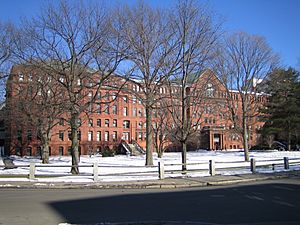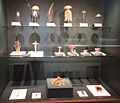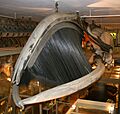Harvard Museum of Natural History facts for kids
 |
|
| Lua error in Module:Location_map at line 420: attempt to index field 'wikibase' (a nil value). | |
| Established | 1998 (by merger of 3 earlier museums) |
|---|---|
| Location | 26 Oxford Street, Cambridge, Massachusetts 02138 |
| Collection size | 12,000 |
| Visitors | 210,000 (2013) |
| Owner | Harvard University |
| Public transit access | Harvard (MBTA Red Line) |
The Harvard Museum of Natural History (HMNH) is a museum filled with amazing treasures from the natural world. It is located on the campus of the famous Harvard University in Cambridge, Massachusetts.
The museum shows off about 12,000 items from three of Harvard's huge research collections: the Harvard University Herbaria (which studies plants), the Museum of Comparative Zoology (which studies animals), and the Harvard Mineralogical Museum (which studies minerals).
When you visit, you also get to see the Peabody Museum of Archaeology and Ethnology, which is right next door and connected to it. One ticket lets you explore both museums! These museums are part of a group called the Harvard Museums of Science and Culture.
Contents
What Can You See at the Museum?
The Harvard Museum of Natural History was created in 1998 to share Harvard's incredible collections with everyone. The exhibits are designed by Harvard's own scientists and experts.
Amazing Animal Exhibits
In the museum's main galleries, you can explore the incredible variety of life on Earth. You'll see everything from giant dinosaurs to tiny fossils of ancient sea creatures. There are also exhibits on large mammals, birds, and fish.
One of the most famous sights is the world's only mounted skeleton of a Kronosaurus, a huge sea reptile that lived millions of years ago. You can also see the massive skeleton of a right whale hanging from the ceiling!
Dazzling Gems and Minerals
The mineral galleries are like a treasure chest. You can see sparkling gemstones, colorful minerals from all over the world, and even pieces of meteorites that have fallen from space. It's a great place to learn about the building blocks of our planet.
The Famous Glass Flowers
One of the museum's most popular exhibits is the Ware Collection of Blaschka Glass Models of Plants, better known as the Glass Flowers. These are thousands of incredibly realistic models of plants made entirely out of glass. They are so detailed that they look real!
There is also a special exhibit called Sea Creatures in Glass. These are glass models of jellyfish, octopuses, and other soft-bodied sea animals. Like the flowers, they were made by the same talented artists, Leopold and Rudolf Blaschka, over 100 years ago.
Visiting the Museum
The museum is a popular spot for people living in and around Boston. Back in 2013, it had over 210,000 visitors, making it the most-visited museum at Harvard.
The museum also offers fun educational programs for students and lectures for the public. Sometimes, they even have travel programs where you can explore nature with Harvard scientists.
Gallery
-
The giant skeleton of a right whale hangs from the ceiling.
See also
 In Spanish: Museo de Historia Natural de Harvard para niños
In Spanish: Museo de Historia Natural de Harvard para niños







